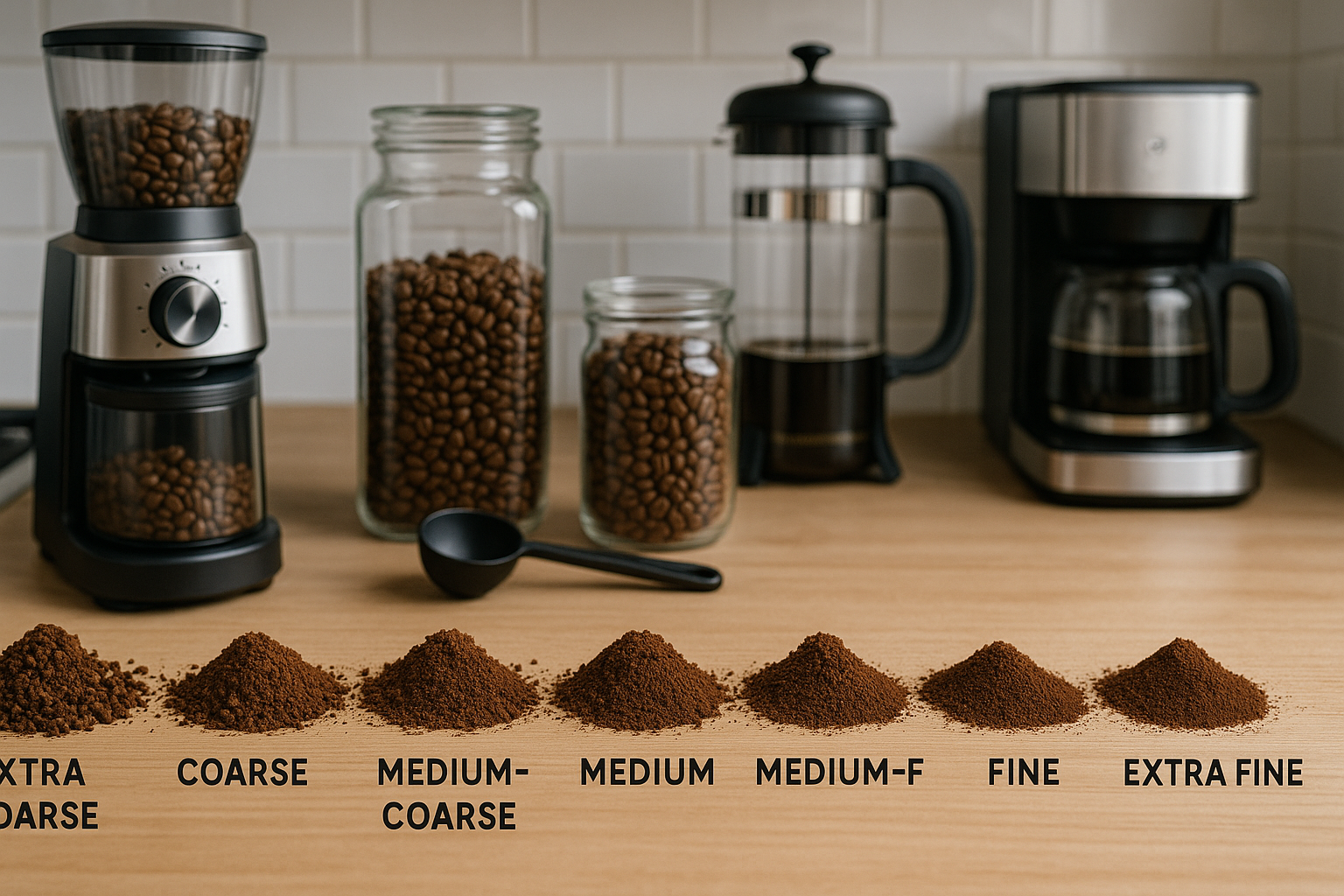Grinding coffee may seem like a simple step, but it’s one of the most crucial elements in brewing the perfect cup. The grind size influences flavor, strength, extraction, and even how bitter or sour your coffee tastes. In this guide, you’ll learn exactly how to grind coffee correctly for each method, and how to get the most out of your beans.
Why Grinding Matters
Coffee starts to lose its flavor minutes after it’s ground. But the size and consistency of your grind also affect:
- Extraction time
- Flavor clarity
- Body and texture
- Strength and aroma
Using the wrong grind for your brewing method can lead to under-extraction (sour, weak) or over-extraction (bitter, harsh).
Types of Coffee Grinds (From Coarse to Fine)
Before matching grind sizes to brewing methods, let’s define the grind types:
| Grind Type | Texture Description |
|---|---|
| Extra Coarse | Rock salt |
| Coarse | Sea salt |
| Medium-Coarse | Rough sand |
| Medium | Regular sand |
| Medium-Fine | Table salt |
| Fine | Flour-like |
| Extra Fine | Powdered sugar (used for Turkish) |
Matching Grind Size to Brewing Method
Here’s how to get it right:
1. French Press – Coarse Grind
- Why: Allows for long steeping without over-extracting.
- Texture: Like sea salt.
- Tip: If your coffee is too silty, your grind might be too fine.
2. Cold Brew – Extra Coarse Grind
- Why: Cold water extraction takes 12–24 hours; coarse grind prevents bitterness.
- Texture: Like chunky rock salt.
- Tip: Filter carefully to avoid grounds in the final cup.
3. Drip Coffee Maker – Medium Grind
- Why: Standard automatic brewers need balanced extraction.
- Texture: Like regular sand.
- Tip: Too fine = bitter; too coarse = watery.
4. Pour-Over (V60, Chemex) – Medium to Medium-Fine
- Why: Control over flow rate impacts extraction.
- Texture: Somewhere between table salt and sand.
- Tip: Adjust grind if brew is too slow (too fine) or too fast (too coarse).
5. AeroPress – Medium-Fine to Fine
- Why: Depends on steep time and pressure.
- Texture: Like fine sand.
- Tip: For short brews (under 1 min), use finer grinds.
6. Espresso – Fine Grind
- Why: High-pressure, fast extraction requires a fine grind.
- Texture: Slightly finer than table salt.
- Tip: If espresso runs too fast or lacks crema, go finer.
7. Moka Pot – Medium-Fine to Fine
- Why: Similar to espresso but with less pressure.
- Texture: Like fine sand, slightly less than espresso.
- Tip: Avoid using espresso grind—it can clog your moka pot.
8. Turkish Coffee – Extra Fine
- Why: Coffee isn’t filtered—grounds stay in the cup.
- Texture: Like powdered sugar.
- Tip: Use a special Turkish grinder or high-quality burr grinder.
Burr vs. Blade Grinders: What to Use
Blade Grinders
- Pros: Cheap, accessible.
- Cons: Inconsistent grind sizes.
- Best for: Beginners or casual drinkers.
Burr Grinders (Conical or Flat)
- Pros: Even grind size, more control.
- Cons: More expensive, bulkier.
- Best for: Serious coffee lovers.
Tip: If flavor matters to you, invest in a burr grinder.
Tips to Get the Perfect Grind
- Grind fresh: Only grind what you’ll brew.
- Weigh your beans: Use a digital scale.
- Clean your grinder: Prevent flavor transfer.
- Dial in: Make small changes based on taste.
Troubleshooting Common Grind Problems
| Problem | Possible Cause | Solution |
|---|---|---|
| Coffee tastes bitter | Grind too fine | Try a coarser grind |
| Coffee tastes sour | Grind too coarse | Try a finer grind |
| Coffee brews too slowly | Grind too fine | Go coarser |
| Coffee brews too quickly | Grind too coarse | Go finer |
| Sludge in French press | Grind too fine | Use coarse grind |
Final Stir: Grind With Purpose
Grind size isn’t just a detail—it’s the foundation of flavor. Getting it right transforms your coffee from “just okay” to “absolutely amazing.”
So next time you brew, ask yourself:
- Am I using the right grind?
- Is my grinder giving me consistency?
- Am I adjusting based on taste?
Master these, and you’re well on your way to becoming your own barista.
